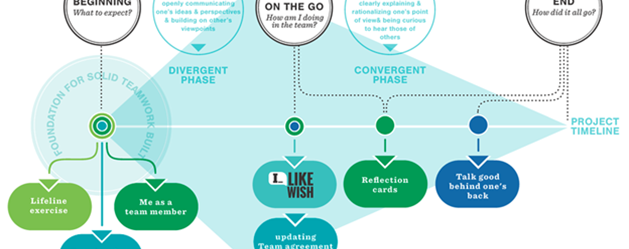Collaborative learning and the power of group roles
Today’s pedagogy brings to the fore collaborative learning as a method of flipped classroom strategies. The flipped classroom model inverts the roles of traditional teacher vs. student. Here, the student takes a more active role by discussing, finding material, analysing information and engaging in problem-solving through various methods.
Many studies have highlighted advantages and effectiveness of flipped classroom methods. One of these studies was conducted by J. Nouri [1]. The result of Nouri’s study indicated that the reasons for students’ perceptions of increased and more effective learning are associated with 1) the affordances of video lectures (the ability to reflect and learn at one’s own pace); 2) more meaningful practice-oriented and teacher-supervised classroom activities and 3) more supported learning processes due to teacher and peer scaffolding in and out of class through the use of Moodle.
I have found interesting and challenging how flipped learning methods are presented through group work and peer review. Particularly interesting is how groups are formulated, how individuals work together in a group, and the psychological forces acting on the interaction of people who quite often do not know each other beforehand.
A familiar situation is meeting an old childhood friend whom you haven’t seen in, say, 20 years. Your friend was, perhaps, a sort of “leader” of your group and decided what to play and even set the rules of the game. You, on the other hand, were a conformist with many ideas, but eventually it was your friend who decided which idea was the applicable one. Now, when you meet each other after a very long time, you briefly catch up on how you are doing and decide to have a drink somewhere to chat and reminiscence on old days. You mention a few restaurants you like, but your friend says they have wanted to try out this new place and suggest going there. You, of course, agree. This situation can happen to anyone anywhere, but more often than not you slide back to your old roles, and perhaps they are the same ones you find yourself most comfortable in even after 20 years.
The roles we are subconsciously prone to take in a group usually reflect our personalities, but the roles are not always fixed and could be flipped around intentionally. Since the 50’s, many studies have examined team roles and how roles contribute to team effectiveness. The usual roles in a work environment [2] are facilitator (usually the leader), initiator, arbitrator, note-taker, coach, coordinator, evaluator or compromiser. The team is very likely most effective when there are several roles which all contribute to the common goal.
A while ago I came up with a game where students examine (through several small tasks) their typical role in a group and then form a situation where they intentionally mix them up. This contributed to the awareness of how roles affect group communication. After the game, the vast majority of students reported feeling more at ease and felt a sense of common understanding while doing the actual group work and leaned towards being more positive in peer review.
T. Driskell, J. Driskell, C. Shawn Burke and E. Salas [3] presented a three-dimensional model (termed TRIAD [Tracking Roles in and Across Domains]) that comprises the dimensions of Dominance (high dominance vs. low dominance), Sociability (high sociability vs. low sociability), and Task Orientation (high task orientation vs. low task orientation). The assumption is that any role can be mapped onto this three-dimensional space. For example, we may expect that the role of team leader would occupy a location having high dominance, moderate sociability, and high task orientation in this space.

Figure 1. The TRIAD. T. Driskell, J. Driskell, C. Shawn Burke and E. Salas [3]
Where would you place yourself or your role in a group on this map?
Author: Silvana Pérez Läherinta
[1] Nouri, J. The flipped classroom: for active, effective and increased learning – especially for low achievers. Int J Educ Technol High Educ 13, 33 (2016).
https://doi.org/10.1186/s41239-016-0032-z
[2] Indeed Editorial Team, 10 Group Roles for Workplace Teams. 2021.
https://www.indeed.com/career-advice/career-development/group-roles
[3] T. Driskell, J. E. Driskell, C. Shawn Burke, E. Salas. Team Roles: A Review and Integration. (2017)
https://doi.org/10.1177/104649641771152

